Shipyard Employment eTool
Barge Cleaning Operations >> Common Hazards
The following safety and health information for barge Cleaning operations should be reviewed. Additional requirements may apply for barges requiring repairs. For these requirements, see Ship Repair module.
- Opening covers
- Fall hazards
- Hazardous material assessment
- Static electricity Hazards
- Fire and explosion hazards
- Respiratory hazards
- Corrosive and toxic material hazards
- Excessive noise hazards
- Biological hazards
- Limited access hazards
- Slip and trip hazards
- Work environment temperature related hazards
- High-pressure hazards
- Electrical hazards
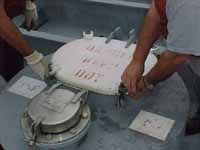
Take precautions when opening covers to tanks, and other confined or enclosed spaces, in the event the space is under pressure or hazardous materials have leaked from internal piping systems.
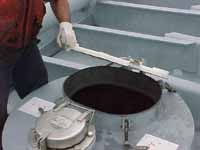
Typically, you should leave at least two nuts on opposite sides of the cover in place until the cover can be cracked and any internal pressure released. If there are other indicators of hazardous material leakage, inform the Shipyard Competent Person (SCP).
See Fall Hazards.
- When opening dry bulk cargo barge covers, refer to 29 CFR 1918 Subpart E, Opening and Closing Hatches for additional precautions. Note: This reference is for informational purposes only and is not required in Shipyard Employment.
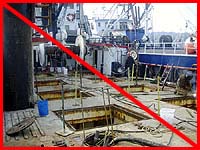
Potential Hazards
Fall hazards are a leading cause of fatalities. Barge cleaning workers are often required to work in dangerous environments that may include fall hazards. Accidents involving elevation equipment (such as ladders and scaffolds) are often serious, even fatal. Workers are also at risk to falls from open deck edges.

High-Pressure Cleaning
- Sudden changes in hose line pressure may throw a worker from the work surface.
- Cleaning can create static electricity. This may shock the worker and result in a fall.
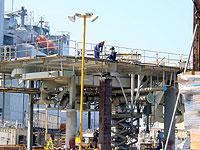
Deck Openings and Edges
- Falls from unguarded deck openings and edges
- Falls into open holes
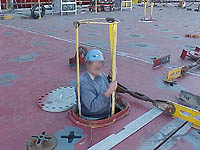
Requirements and Example Solution
- Workers must be protected by proper fall protection. [29 CFR 1915.152]
Guarding of Deck Openings and Edges
- Openings and deck edges must be guarded. [29 CFR 1915.73]
- Flush manholes and other small openings must be guarded after opening. [29 CFR 1915.73(b)]
- Fall protection (harness with lanyard) must be used during the installation of guards on deck openings and edges. [29 CFR 1915.73(d)]
Additional Resource
- Fall Protection. OSHA Safety and Health Topics Page.
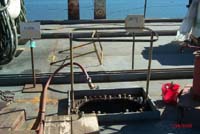
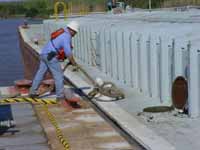
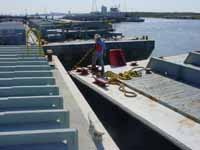
Previous cargoes must be determined. If they contained hazardous materials, workers should be informed of the hazards and how to safely work with them. As part of the Hazard Communication standard [29 CFR 1915.1200], material safety data sheets (MSDS) for the cleaning solutions must be available for ready reference. Personnel must be provided with information contained in the MSDS such as: chemical name, hazard information, personal protective equipment (PPE), etc.
- Removal, disposal, and/or recycling of residue and by-products (such as contaminated clothing, PPE, rags and cleaning supplies) from Shipyard Employment operations should be in accordance with local, state, and federal regulations/requirements.
- Work closely with the owner of the barge to obtain information on the last three cargoes.
Additional Resources
- NIOSH Pocket Guide
- NFPA 306, Control of Gas Hazards on Vessels. National Fire Protection Association.
- 33 CFR, Subpart 154 - Facilities Transferring Oil or Hazardous Materials in Bulk. This regulation is available on-line through the GPO Access website.
- 154.735 - Safety Requirements. U.S. Coast Guard. This regulation allows for the incorporation of the International Safety Guide for Oil Tankers & Terminals (ISGOTT) guide for tank cleaning under 33 CFR 154.735(s)(1-3).
- OCIMF International Safety Guide for Oil Tankers & Terminals. International Chamber of Shipping (ICS). This document outlines the international standard for cleaning tanks.
- Safety Guidelines For Tank Vessel Cleaning Facilities. American Waterways Shipyard Conference. This guideline was created by the American Waterways Shipyard Conference (AWSC). AWSC merged with the Shipbuilders Council of America (SCA) in 1999.
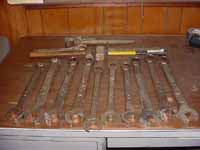
Potential Hazards
Static electricity can be generated in barge cleaning operations by:
- Friction of different metals
- Movement of grain
- Transfer of liquids
- Mechanical ventilation (such as pneumatic, non-sparking, air movers)
- Vessel docking
- Atmospheric conditions
- Movement of water around the vessel
- Clothing (such as nylon or polyester fabrics, conductive shoes)
- Conductive tools (such as shovels, scrapers, wrenches, and wire brushes) High-pressure washing. See the High-Pressure Hazards cards.
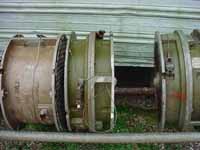
Requirements and Example Solutions
When barge cleaning operations are capable of producing static electricity:
- Equipment that may generate static electricity such as ventilation systems must be grounded/bonded. [29 CFR 1915.13(b)(11)].
- Arcing and sparking equipment and tools must not be used. [29 CFR 1915.36(a)(1)].



- Flammable liquids should be transferred by using bonded hoses (such as static hoses) or adequately bonded containers (such as drums, cans, or portable tanks). Hoses should be tested to ensure continuity prior to use.
- During all vessel docking operations, the bonding cable should be attached to the vessel prior to grounding to avoid sparking.
- Precautions should be taken to eliminate sources that may create static electricity before and while lifting devices are used on vessels to hoist with flammable/combustible liquids.
- Precautions should be taken when low humidity conditions increase the probability of static electricity.
- If flammable solvents are involved in the operation, non-static discharge producing shoes/boots and shoe covers should be used.
Note: No one can work in a space that contains an atmosphere above 10% of the lower explosive limit (LEL). [29 CFR 1915.12, 29 CFR 1915.13, 29 CFR 1915.14].
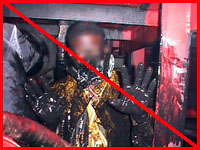
Potential Hazards

Fire and explosions may be caused by:
- Flammable and combustible cleaning solvents such as Methyl Ethyl Ketone (MEK), mineral spirits, and diesel fuel/oil
- Liquids with high flash points (greater than 100º F) applied as a fine mist
- Airborne particulate or dust
- Hydrogen gas generated during cleaning processes
- Reactive cargoes such as iron-ore, fertilizer, or incompatible chemicals
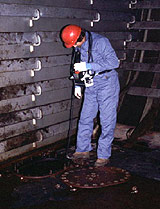
Requirements and Example Solutions
When barge cleaning operations are capable of producing flammable/combustible atmospheres:
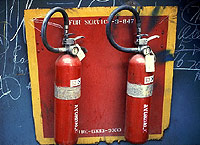
- Hot work must not be performed. [29 CFR 1915 Subpart B]
- Rags soaked with solvents must be placed in covered metal containers. [29 CFR 1915.36(a)(3)]
- No smoking or open flames are allowed. [29 CFR 1915.36(a)(1)]
- Arcing and sparking equipment and tools must not be used. [29 CFR 1915.36(a)(1)]
- Equipment that may generate static electricity such as ventilation systems must be grounded/bonded. [29 CFR 1915.13(b)(11)].
- Explosion-proof lights must be used. [29 CFR 1915.36(a)(4) and 29 CFR 1915.13(b)(9)]
- Adequate ventilation must be maintained (less than 10 percent of lower explosive limit (LEL)). [29 CFR 1915.13(b)(3) and 29 CFR 1915.36(a)(2)]
- Frequent tests shall be required during cleaning operations to determine if air concentrations are below 10 percent of the LEL. [29 CFR 1915.36(a)(2)]
- The Shipyard competent person must test the exhaust location to ensure that exhausted vapors do not accumulate to hazardous levels. [29 CFR 1915.13(b)(7), (b)(8), (b)(11), and (b)(12)]
- Suitable fire fighting equipment must be immediately available. [29 CFR 1915.36(a)(6) and 29 CFR 1915 Subpart P]
- Personnel using fire fighting equipment must be instructed in anticipated fire hazards and how to use the equipment. [29 CFR 1915 Subpart P]
- Spills of solvents must be cleaned up immediately. [29 CFR 1915.13(b)(5)]
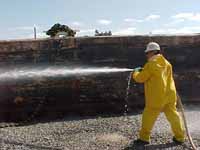
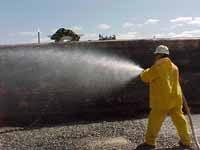
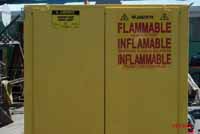
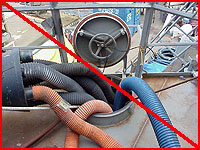
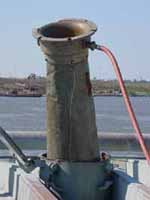
Potential Hazard
The most hazardous conditions in barge cleaning operations occur while exposing workers to oxygen-deficient atmospheres and toxic atmospheres. Toxic vapors may be produced by the previous cargo or cleaning agents and could present significant health hazards. When encountered in confined or enclosed spaces, these agents produce vapors that are often heavier than air. This can cause displacement of air, reducing oxygen levels, which may be fatal.
Requirements and Example Solutions
- Ensure adequate ventilation to maintain air concentrations below the permissible exposure limit (PEL). [29 CFR 1915.32(a)(2)]
- The Shipyard Competent Person may require continual monitoring to determine that air concentrations are within the PELs and below immediately dangerous to life or health (IDLH) levels. If they are not, additional engineering controls such as ventilation, administrative controls, or PPE such as respirators must be used. [29 CFR 1915.32(a)(3) and Maritime Labor/Industry Recommendations]
- While ventilation is useful in allowing for safe air concentrations, it is crucial that the supplied air be tested to ensure it is from a clean source.
- Airline respirators may be necessary if ventilation is not adequate.
- Respirators must comply with 29 CFR 1915.154. [29 CFR 1910.134]
- A hazard assessment shall be done to determine the proper selection of respirators. [29 CFR 1915.152(b)]
Additional Resources
- Ventilation. See the Confined or Enclosed Space: Ventilation section.
- Respiratory Protection. OSHA eTool.
- Inspection procedures for the Respiratory Protection Standard. OSHA Directive CPL 02-00-158, (June 26, 2014).

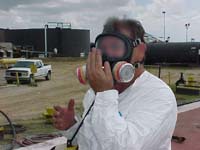
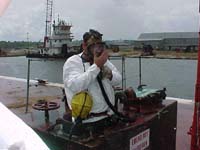
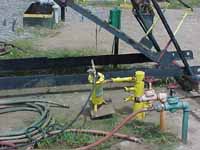
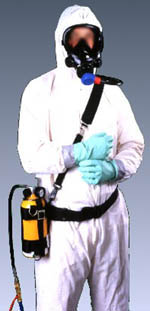
- Activities such as disturbing or removing sludge or scale, materials trapped below water, leaking pipelines or valves, and variation in temperature may cause atmospheric conditions to change. Frequent or continuous monitoring may be necessary.
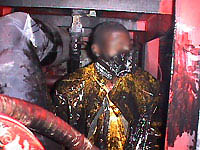
Potential Hazards
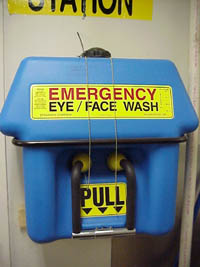
Workers using toxic and/or corrosive cleaning solutions are at risk if inhaled, or skin or eye contact occur. Note: Workers should understand the hazards associated with the materials used and contained in the space. This includes training in accordance with the Hazard Communication standard, (29 CFR 1915.1200). Hazards include:
- Organ damage by absorption through the skin or eye
- Eye or skin irritation
- Defatting of skin
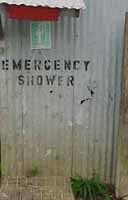
Requirements and Example Solutions
- Use adequate ventilation. See the Confined or Enclosed Space: Ventilation section.
- The Shipyard competent person may require continual monitoring to determine that air concentrations are within the PELs and below IDLH levels. If they are not, additional engineering controls such as ventilation, administrative controls, or PPE such as respirators must be used. [29 CFR 1915.32(a)(3)]
- Spills of hazardous materials must be cleaned up as work progresses. [29 CFR 1915.13(b)(5)]
- Because of the corrosive nature of many of the materials used, suitable facilities for quick drenching or flushing of the eyes and body shall be available. [29 CFR 1910.151(c) and Maritime Labor/Industry Recommendations]
- Washing facilities must be available when working with materials which may be harmful through skin contact. [29 CFR 1915.88(e)]
- Personal hygiene practices must be encouraged, such as washing hands and face before eating, drinking, and smoking. [29 CFR 1915.88(e)(3)]
- See the PPE Selection: Cleaning and Other Cold Work module.

Additional Resources
- Hazard Communication Guidelines for Compliance. OSHA Publication 3111, (2000).
- Hazard Communication. OSHA Safety and Health Topics Page.
- Fixed or portable eye wash stations/safety showers should meet ANSI Z358.1-2004: Emergency Eye Wash and Shower Equipment.
- Activities such as disturbing or removing sludge or scale, materials trapped below water, leaking pipelines or valves, and variation in temperature may cause atmospheric conditions to change. Frequent or continuous monitoring may be necessary.
- Engineering Controls
- Administrative Controls
- Personal Protective Equipment (PPE)
Potential Hazards
Use of high-pressure cleaning equipment may produce high levels of noise, which could lead to hearing loss, and often necessitates a hearing conservation program. Some examples of excessively loud operations are:
- Use of high-pressure water and steam guns
- Use of pumps
- Use of generators
- Use of ventilation equipment

Requirements and Example Solutions
- Hearing protection. [29 CFR 1910.95(a)]
- Hearing conservation program. [29 CFR 1910.95(c)]
- Hearing protectors (such as earplugs or muffs). [29 CFR 1910.95(i)]
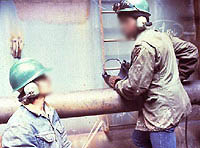
Additional Resources
- PPE Selection: Hearing Protection. See the PPE Selection: Cleaning and Other Cold Work section of this eTool.
- Noise. OSHA Technical Manual Chapter.
- Occupational Noise Exposure. OSHA Safety and Health Topics Page.
- 29 CFR 1910.95(b)(1), Guidelines for Noise Enforcement; Appendix A. OSHA Directive CPL 02-02-035 [CPL 2-2.35A], (December 19, 1983).
- Purchase or modify equipment to reduce noise levels.
- Isolate or locate noisy equipment away from workers.
- Shield noisy equipment.
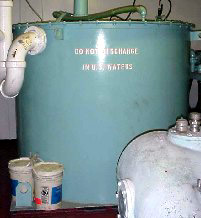
Potential Hazards
Some operations expose employees to biological hazards from sewage and human waste, fungi and molds, and decomposing organic products.
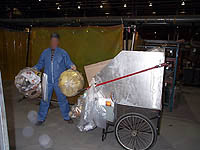
- Collection, holding, and transfer (CHT) tanks, which workers are often required to enter and clean, may contain dangerous, even fatal, levels of hydrogen sulfide or other toxic gases, which are products of decomposing human waste.
- Toxic spores inhaled from fungi and molds growing on grain and lumber may pose an inhalation hazard.
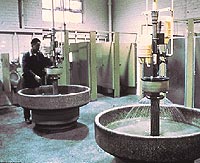
Requirements and Example Solutions
- Employees shall be trained to recognize the potential hazards, use proper work practices, recognize adverse health effects, and understand the physical signs and reactions related to exposures. They shall also be trained to select and use appropriate PPE. [29 CFR 1915.12(d)(2) and 29 CFR 1915.1200]
- Personal hygiene practices must be encouraged, such as: [29 CFR 1915.88]
- Decontamination (removal of biological matter from PPE and equipment)
- Showers (removal of biological matter from the worker) [29 CFR 1915.88(f)]
- Proper disposal of laundry/coveralls (prevention of exposure to others)
Additional Resources
- Bloodborne Pathogens and Needlestick Prevention. OSHA Safety and Health Topics Page.
- Mold. OSHA Safety and Health Topics Page.
- Maritime Labor/Industry recommends having a Bloodborne Pathogens program.
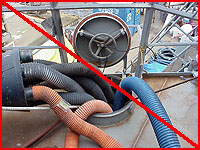
Potential Hazards
When working in confined or enclosed spaces, egress may be blocked by:
- Improperly located equipment
- Ventilation ducts and hoses running through the opening
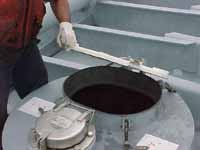
Requirements and Example Solutions
- When employees work in confined or enclosed spaces with limited access, the access must not be blocked or impeded by ventilation ducts, hoses, or other equipment. [29 CFR 1915.76(b)(2)]
- More than one means of access must be provided where practical. [29 CFR 1915.76(b)(1)]
- Additional openings should be considered for ducts, hoses, and other equipment.
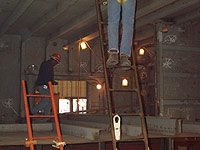
Potential Hazards
Workers performing barge cleaning operations are exposed to slippery working surfaces and tripping hazards. This places workers at risk of:
- Slipping off oily and greasy ladders
- Slipping and falling on oily decks
- Tripping over equipment, hoses, and vessel structures
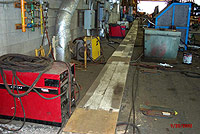
Requirements and Example Solutions
- Spills must be cleaned up immediately. [29 CFR 1915.13(b)(5) and 29 CFR 1915.81]
- Visual Inspection must be conducted. See Confined or Enclosed Space module.
- Adequate Illumination will be provided. See Confined or Enclosed Space module.
- Housekeeping as described in 29 CFR 1915.81 will be maintained.
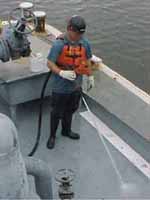

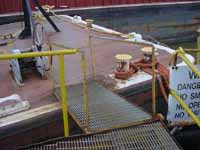

Potential Hazards
Extreme environmental hazards include temperature, humidity, and air movement within the work area. A combination of PPE use, heat-producing equipment, work activity, and environmental conditions can cause temperature-related illnesses.
Heat-related illnesses include:
- Heat Stress
- Heat Stroke
- Heat Cramps
- Dehydration
Cold-related illnesses include
- Hypothermia
- Frostbite
Additional Resources
- Section III: Chapter 4, Heat Stress. OSHA Technical Manual.
- Occupational Heat Exposure. OSHA Safety and Health Topics Page.
Example Solutions
Maritime Labor/Industry recommends the following for heat-related illnesses:
- Plenty of fluids
- Frequent breaks
- Ice vest
- Shaded or cooled break areas
- Ventilation
- Awareness training
Maritime Labor/Industry recommends the following for cold-related illnesses:
- Appropriate insulated PPE
- Warming areas for breaks
- Awareness training
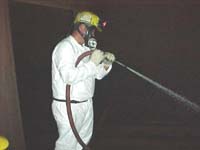
Potential Hazards
The use of high-pressure cleaning equipment may expose the operator and other workers in the area to the following hazards:
- Contact with high-pressure steam, water, or air streams from cleaning equipment
- Contact by uncontrolled high-pressure hoses
- Contact with steam, water, or air leaks in the high-pressure equipment
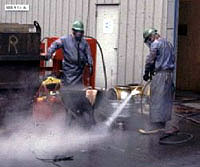
Injuries associated with these hazards include:
- Loss of body parts such as fingers, hands, toes, etc.
- Lacerations
- Burns
- Loss of sight
- Infections from water and debris trapped under the skin
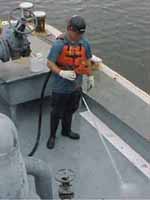
Requirements and Example Solutions:
- Steam guns must be insulated to prevent heat burns to the operator. [29 CFR 1915.33(e)]
- Appropriate PPE shall be used. [29 CFR 1915.152]
- Access to the area should be controlled.
- Hoses and connections should be inspected before each use.
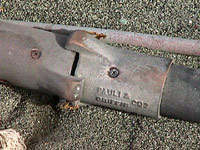
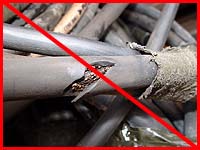
Potential Hazards
Employees who work with or around electrical equipment in wet or damp locations have an increased risk of getting shocked or electrocuted due to:
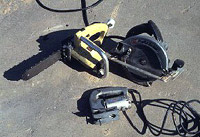
- Exposed energized electrical parts
- Open lighting parts (such as broken bulbs, exposed conductors)
- Damaged insulation on power cords
Electrical equipment (unless this equipment is explosion proof or intrinsically safe) must not be used on hot barges until they are gas free (such as barges that have contained flammable/combustible material including gasoline, methanol, styrene, toluene, etc.). Non-explosion proof or non-intrinsically safe electrical equipment may be used on a barge after it has been determined the barge is gas-free.
[29 CFR 1915.36]
Note: Arcing and spark producing tools are not to be used where flammable liquids are capable of creating a flammable atmosphere. [29 CFR 1915.36]
Requirements and Example Solutions
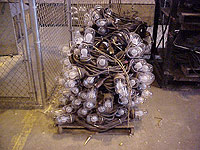
- Portable electric tools must be grounded or double insulated. [29 CFR 1915.132(a)]
- Temporary lighting must be grounded. [29 CFR 1915.82(b)(8)]
- Power and lighting cables must be inspected by a person competent to evaluate electrical hazards. (Note: This is not the Shipyard Competent Person). [29 CFR 1915.36(a)(5)]
- All electrical tools or equipment should undergo a visual inspection before use.
- All portable electric hand tools and temporary lighting systems should use Ground-Fault Circuit Interrupters (GFCI).
- Electrical tools and equipment should correspond with the requirements of the job.
- Electrical equipment and tools should be used with proper circuit protection for the voltage and amperage used.
- Only qualified electricians should attempt repair of electrical tools and equipment in use.
- A Ground Assurance Program should be in place for all electrical tools and equipment used including:
- Records of tools inspected and repaired
- Records of electrical boxes inspected and repaired
- Records of electrical extension cords inspected and repaired
- Recall of records of the above
- The requirements of the Ground Assurance Program should be performed on a regular basis.

